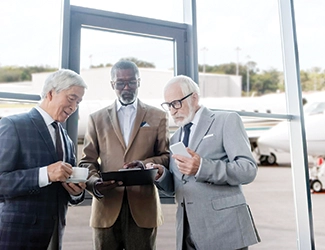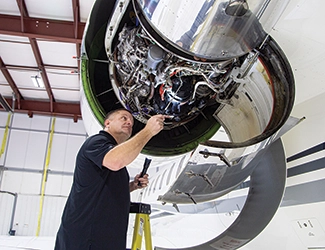Aircraft operating costs
Calculating the cost of business jet and turboprop ownership.
By Shannon Forrest
Contributing Writer

The reality TV show Selling Jets debuted in 2015 and became a featured series on the AWE channel. Like all reality TV, the show was heavily scripted, and the plots were devised to elevate the drama. Most of the episodes focused on first-time jet buyers that ran the gamut from the recently rich to CEOs of mid-sized companies.
Regardless of how plausible or concocted the plot was, a theme that was readily apparent in all the episodes was the intense focus on the sales price. Although the acquisition cost warranted scrutiny, it was the lack of attention or concern for the operating costs that made anyone with knowledge of the expenses associated with operating an airplane chuckle and groan.
In 2015 and the years that followed, loans were easy to obtain for aircraft below $1.5 million. Well off couples on the show would become giddy with excitement when they realized a jet cost “only a million dollars.” They immediately wanted to sign the purchase agreement on that classic Gulfstream II that was only slightly out of annual inspection and hadn’t flown in 2 years.
Occasionally, someone asked what it would cost for a pilot. The salesperson would respond that the aircraft in question required 2 pilots, but the second could be had for less than the first. The salary numbers quoted at the time were so vastly under market when compared to today’s compensation rates that the new jet owners would be hard-pressed to get anyone to show up for an interview. Of course, you get what you pay for.
An old misconception
Miscalculating the true cost of aircraft ownership likely originates in the early days of flight training. Flight schools advertise an hourly rate, and the student pays it without thinking about what goes into the calculation. Things like oil and tire changes, engine and avionics reserves, annual inspections, and insurance premiums aren’t discussed with student pilots. If the plane is rented “wet,” it includes the cost of fuel. Otherwise, the student pays a “dry rate” to the flight school and pays the fuel supplier directly for fuel consumed during the flight.
This “gas it and go” mentality can persist when a pilot becomes and aircraft owner. It’s one reason why aircraft sales publications are top heavy with airframes at or near engine overhaul times. Owners who never allow for the cost of overhaul typically resort to selling the aircraft when faced with a 5-figure bill to return a run out engine to service.
The same is true for turboprops. Two decades ago, the Mitsubishi MU-2 B series picked up the moniker of “cheap speed” because one could be purchased for roughly the same as a well-equipped Piper Navajo or Chieftain. MU-2 buyers could go at least 50 kts faster than a comparable twin engine piston at the same acquisition cost, and they could do it in pressurized comfort in the flight levels.
Aside from the additional cost of the Jet A for the turboprop, an uneducated owner may view the 2 aircraft as equal and see the Mitsubishi as a better value. That is until the owner hears the words “hot section” and must write a check in the 6-figure range for turboprop maintenance.
Controller.com currently has a long list of bargain jets on the market. These include a 1980 Cessna Citation I for $440,000 (refurbished in 1996), a 2000 Learjet 31A at $850,000 (12-year inspection due), and a 1985 Gulfstream III at $895,000 (owner financing available). At these rates, a retired high school teacher could sell her home of 40 years in Chula Vista CA (built in 1961 and coming in just under 1400 sq ft) and use the proceeds to purchase a means of going Mach .76 to visit the grandkids. For a very brief period anyway.

Direct operating costs
The actual cost of aircraft ownership is a function of the acquisition cost in additional to what it costs to operate. If the aircraft is financed, calculations must also include interest and other fees associated with the lien on the aircraft.
Operating costs are typically broken down into direct and indirect subcategories. There’s a little subjectivity in what falls into each category, but in general, direct operating costs (DOCs) are defined as any cost related directly to the operation of the aircraft.
DOCs can be quantified per a unit of time, and the most common way to do so is per hour. The most obvious example is fuel. However, even this can be a little tricky to nail down with 100% accuracy. Fuel calculations are based on power settings, and consumption varies as a function of altitude and speed.
A turbine aircraft assigned to descend early (far from the destination) and given extensive vectoring down low will consume more fuel per hour than the same aircraft with a more efficient routing. In addition, the variable cost of fuel can cause the cost per hour to fluctuate. Industry standard is to use the average consumption at cruise and an average price to calculate the cost. It’s close but not perfect.
Scheduled interval-based repair, replacement, or refurbishment can also be accounted for by using hourly cost accounting. A maintenance event at a fixed cost occurring at a fixed interval can be assigned an hourly cost. This is commonly known as a “reserve,” and savvy operators include engine and avionics reserves as a line-item DOC expense.
Being disciplined to account for and set aside cash for every hour flown and slating that money for maintenance, repair, and overhaul avoids large financial burdens down the road. Failure to account for this is what causes a significant percentage operators to sell the airplane rather than repair it.
Upfront costs in the from of modifications can reduce hourly DOCs and be financially favorable over the long run. For instance, Blackhawk Aerospace contends that the PT6A-135A modification for the King Air C90 saves time and fuel with a faster cruise speed and time to climb. The company estimates that the reserve on a stock C90 engine (PT6A-21) is $153.39/hour, whereas the Blackhawk upgrade reduces the DOC reserve to $127.28/hour. The roughly $25 per hour difference may not sound like much, but over a 3600-hour interval, that equates to almost $100,000.
Minimizing the sticker shock of an unexpected maintenance expense can be accomplished by applying a general maintenance reserve for each hour flown. Using historical yearly maintenance average costs can provide a baseline.
Crew salary is a DOC that can be categorized hourly. However, nearly all pilots at the corporate level or flying for private owners are paid a yearly salary rather than an hourly fee. One exception is contractors (used to fill in for vacations, training, and unplanned absences) who are typically paid a daily rate or a rate for a specific trip.
It’s important for aircraft owners to be realistic and consider the market when hiring crew members. Airlines are offering record salaries, and that’s been the impetus for many corporate pilots to change career tracks. Two of the biggest complaints during exit interviews are – predictably – the desire for an increased salary and days off. Low balling crew pay or forcing an untenable schedule often results in flight department turnover as pilots and cabin attendants seek better offers elsewhere.
Salary is a DOC that must be paid whether an aircraft flies or not. Aircraft insurance is also in this category. There’s lots of variables that factor in computing insurance rates, such as pilot experience, location, or aircraft age. But the one constant is that insurance rates are trending higher year over year. It’s tempting to save money by skimping on insurance (or self-insuring if the aircraft is not financed), but insurance is like a lawyer – it’s best to never have to use it, but when you really need it, you’re glad it’s there.
It’s technically possible to take the yearly insurance rate and divide it by hours flown to derive an hourly cost of insurance. The same is true of hangar or tie down fees, or rent paid to airports or FBOs. Some use this methodology to argue that flying more hours per year extracts a better value per hour than flying less. There’s lots of ways to calculate DOCs, and some are driven by accountants and tax advisors.
The one take away from the airline world is that profits are driven by ancillary products (like loyalty programs and credit cards) not moving people from point to point. Airplanes are time machines in that they trade time for money. DOCs and indirect operating costs almost always exceed expectations and budgets. It’s like the famous aviation adage that asks, “What’s the best way to make a million dollars in aviation?” Start with 2 million and whittle it down.
 Shannon Forrest is a current line pilot, CRM facilitator, and aviation safety consultant. He has more than 15,000 hrs TT and holds a degree in behavioral psychology.
Shannon Forrest is a current line pilot, CRM facilitator, and aviation safety consultant. He has more than 15,000 hrs TT and holds a degree in behavioral psychology.